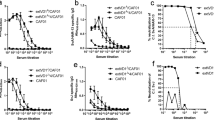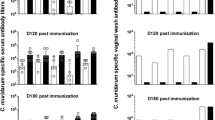Abstract
The chlamydial glycolipid exoantigen, GLXA, is associated with the bacterial membrane, intracellular inclusion, and can also be found secreted into the microenvironment of Chlamydia trachomatis-infected cells. The aim of this study was to investigate the function of GLXA in chlamydial pathogenesis. Pretreatment of HeLa 229 cells with affinity-purified GLXA resulted in a significant enhancement of chlamydial infectivity as determined by inclusion body enumeration. The GLXA-mediated enhancement was shown to be time- and dose-dependent and, more importantly, GLXA-specific, as the effect was abrogated by anti-GLXA antibody. In vitro neutralization assays on HEp-2 cells revealed that an anti-anti-idiotypic antibody to GLXA effectively reduced the infectivity of C. trachomatis, C. pneumoniae, and C. psittaci. In vivo, the co-inoculation of GLXA at the time of C. trachomatis serovar K intravaginal challenge of C3H/HeJ mice resulted in a significant increase in the numbers of shed organisms on days 4, 7, 14, 21, and 28. Taken together, these observations suggest that GLXA, both organism bound and secreted, is important in facilitating the initiation of infection.
Similar content being viewed by others
Author information
Authors and Affiliations
Additional information
Received: 12 April 2002 / Accepted: 8 June 2002
Rights and permissions
About this article
Cite this article
Vora, G., Stuart, E. A Role for the Glycolipid Exoantigen (GLXA) in Chlamydial Infectivity. Curr Microbiol 46, 0217–0223 (2003). https://doi.org/10.1007/s00284-002-3843-1
Issue Date:
DOI: https://doi.org/10.1007/s00284-002-3843-1




